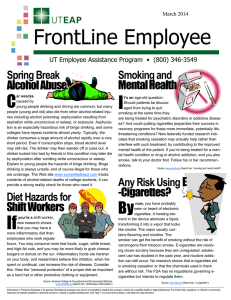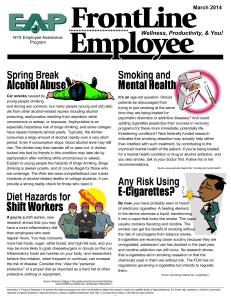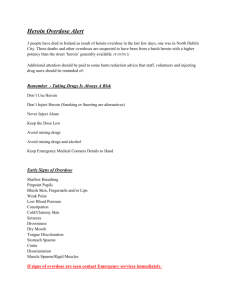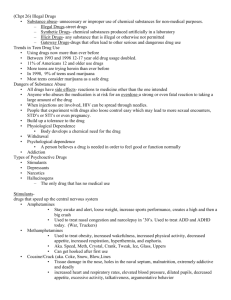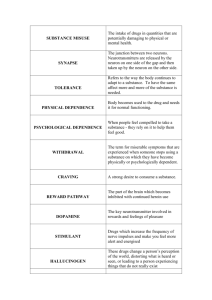Wellness, Productivity, & You!
advertisement
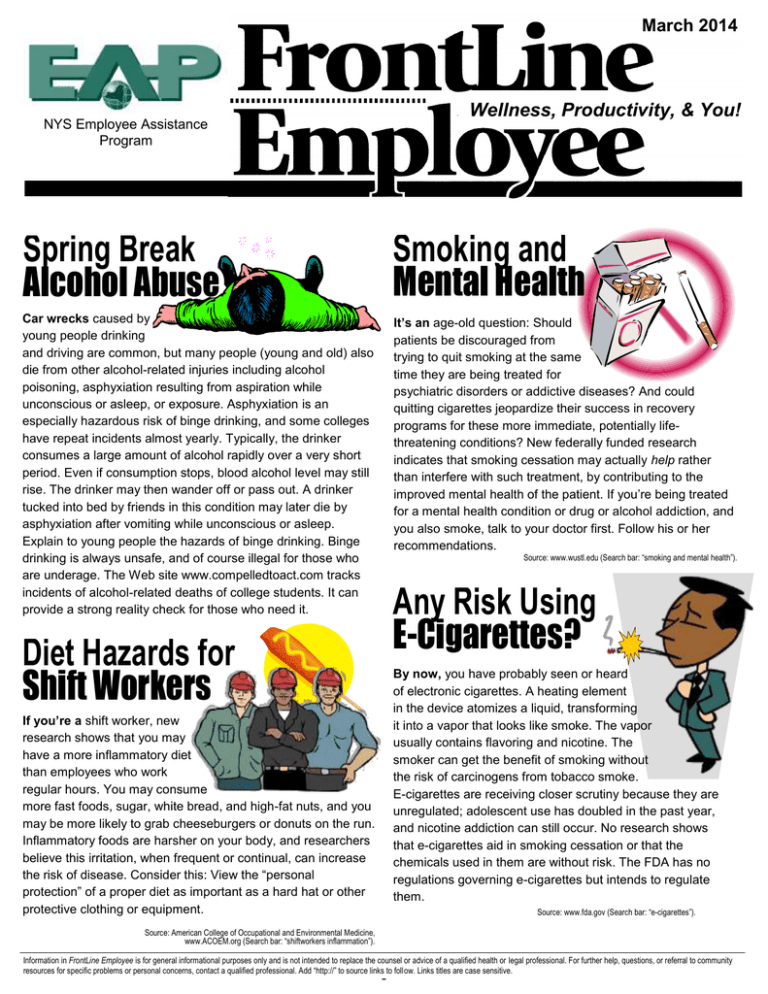
March 2014 Wellness, Productivity, & You! NYS Employee Assistance Program www.worklife.ny.gov/eap Spring Break Alcohol Abuse Smoking and Mental Health Car wrecks caused by young people drinking and driving are common, but many people (young and old) also die from other alcohol-related injuries including alcohol poisoning, asphyxiation resulting from aspiration while unconscious or asleep, or exposure. Asphyxiation is an especially hazardous risk of binge drinking, and some colleges have repeat incidents almost yearly. Typically, the drinker consumes a large amount of alcohol rapidly over a very short period. Even if consumption stops, blood alcohol level may still rise. The drinker may then wander off or pass out. A drinker tucked into bed by friends in this condition may later die by asphyxiation after vomiting while unconscious or asleep. Explain to young people the hazards of binge drinking. Binge drinking is always unsafe, and of course illegal for those who are underage. The Web site www.compelledtoact.com tracks incidents of alcohol-related deaths of college students. It can provide a strong reality check for those who need it. It’s an age-old question: Should patients be discouraged from trying to quit smoking at the same time they are being treated for psychiatric disorders or addictive diseases? And could quitting cigarettes jeopardize their success in recovery programs for these more immediate, potentially lifethreatening conditions? New federally funded research indicates that smoking cessation may actually help rather than interfere with such treatment, by contributing to the improved mental health of the patient. If you’re being treated for a mental health condition or drug or alcohol addiction, and you also smoke, talk to your doctor first. Follow his or her recommendations. Source: www.wustl.edu (Search bar: “smoking and mental health”). Any Risk Using E-Cigarettes? Diet Hazards for Shift Workers By now, you have probably seen or heard of electronic cigarettes. A heating element in the device atomizes a liquid, transforming it into a vapor that looks like smoke. The vapor usually contains flavoring and nicotine. The smoker can get the benefit of smoking without the risk of carcinogens from tobacco smoke. E-cigarettes are receiving closer scrutiny because they are unregulated; adolescent use has doubled in the past year, and nicotine addiction can still occur. No research shows that e-cigarettes aid in smoking cessation or that the chemicals used in them are without risk. The FDA has no regulations governing e-cigarettes but intends to regulate them. If you’re a shift worker, new research shows that you may have a more inflammatory diet than employees who work regular hours. You may consume more fast foods, sugar, white bread, and high-fat nuts, and you may be more likely to grab cheeseburgers or donuts on the run. Inflammatory foods are harsher on your body, and researchers believe this irritation, when frequent or continual, can increase the risk of disease. Consider this: View the “personal protection” of a proper diet as important as a hard hat or other protective clothing or equipment. Source: www.fda.gov (Search bar: “e-cigarettes”). Source: American College of Occupational and Environmental Medicine, www.ACOEM.org (Search bar: “shiftworkers inflammation”). Information in FrontLine Employee is for general informational purposes only and is not intended to replace the counsel or advice of a qualified health or legal professional. For further help, questions, or referral to community resources for specific problems or personal concerns, contact a qualified professional. Add “http://” to source links to follow. Links titles are case sensitive. - March 2014 Violence: What You Can Do about Heroin Heroin is an opioid drug derived from morphine, a naturally occurring substance extracted from the opium poppy plant. Heroin is illegal, with no medicinal purpose, but it has proliferated in the West, nearly doubling its number of regular users since 2007. Heroin is cheaper and purer now, which has contributed to the number of overdoses. Nearly 30% of people who use heroin will become addicted to it and acquire a ferocious urge to seek out and continue using the drug. This gives heroin its reputation as the “hardest” of hard drugs. According to the DEA, as of 2011, nearly 4.2 million people nationwide are believed to have tried heroin. You can help play a prevention role, starting with awareness. Many heroin addicts report using drugs like Oxycontin and Vicodin (two commonly stolen medications) prior to ever using heroin. Both have heroin-like effects when abused. Protect any prescription painkillers from theft, and dispose of old prescriptions properly. Never share them. Do you know a drug addict? Avoid enabling, and act quickly to insist on treatment; arrange for help at a point of crisis, when the addict’s interest and motivation to accept help usually peak. If you miss the opportunity, try again at the next crisis point. Source: www.drugabuse.gov. FrontLine Employee #1 Cause of Workplace Fatalities for Women Don’t think that workplace violence is primarily a problem that affects men. The latest statistics show that the leading cause of death for women in the workplace is not accidents or falls, but homicide. Sound hard to believe? In 2012, 463 workers in the U.S. were killed as a result of violence in the workplace (that’s actually fewer than normal.) Of the 338 fatal injuries involving women, no cause of death was higher than homicide (29%). Still, only sensational acts garner attention in the news. Generally, women are more vulnerable than men to violence from acquaintances, former spouses or partners. Many domestic abuse incidents carry over to the workplace, and workplaces prone to higher rates of violence are often medical and health care, social service, or personal care settings, where a higher percentage of women tend to work. Two-thirds of workplace homicides occur in these types of settings. Source: http://www.bls.gov (Search bar: USDL-13-1699) What’s New about Teen Stress? Teens are about 33 percent more stressed than adults, according to an American Psychological Association “Stress in America Survey” that compared 1,000 teens to 2,000 adults. Teen complaints include a broad mix of school, work, family, and issues with friends. These issues aren’t new, but how teens cope with stress has changed. Unlike 30 years ago, fewer teens exercise regularly; they pick more unhealthy food choices, skip meals more often, and get less sleep. To de-stress, many are drawn to technology, video gaming, and the Internet. Adults practice these less healthy behaviors too, but poor coping skills are showing up earlier. Drugs of abuse are stronger and perceived prohibitions are fewer, adding to the problems teens face. Help your teen by offering coping strategies at an earlier age, when he or she may be more receptive. Invest time in your child regularly, early, and often, and participate in “process communication” so he or she learns and discovers the value of supportive quality relationships, which can help manage stress and solve problems. Source: www.apa.org (Search bar: “teen stress”). - Psychological Treatment of Chronic Pain Are you one of the 116 million Americans who experience chronic pain? Pain costs the country up to $600 billion per year, according the American Academy of Pain Medicine. That includes personal and workplace productivity losses, financial costs, and untold secondary impacts. Finding pain relief can be elusive for many; the answer may not always be a prescription. Less attempted, but often as effective, are psychological interventions. Did you know that some psychologists specialize in pain management? If you experience chronic pain, could your solution lie here? Speak with your health provider or EAP to explore qualified psychological services available for pain management. You may not have tried everything yet.
